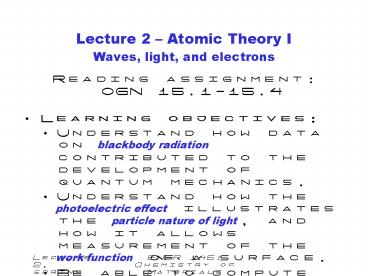ENGR 145: Chemistry of Materials - PowerPoint PPT Presentation
1 / 24
Title:
ENGR 145: Chemistry of Materials
Description:
Understand how data on blackbody radiation contributed to the ... Put a light bulb in a circuit with a variable-voltage power supply, ammeter and voltmeter ... – PowerPoint PPT presentation
Number of Views:41
Avg rating:3.0/5.0
Title: ENGR 145: Chemistry of Materials
1
Lecture 2 Atomic Theory IWaves, light, and
electrons
- Reading assignment OGN 15.1-15.4
- Learning objectives
- Understand how data on blackbody radiation
contributed to the development of quantum
mechanics. - Understand how the photoelectric effect
illustrates the particle nature of light, and how
it allows measurement of the work function of a
surface. - Be able to compute the Bohr radius and allowed
energy levels for electrons in one-electron
atoms.
2
Classical Mechanics vs.Quantum Mechanics
- Classical mechanics energy of a system can be
continuously varied - Quantum mechanics energy states are quantized
- Only true if the energy changes are large
compared to quantum phenomena
3
Wave Motion (OGN 15.1)
- Wave Motion
- Amplitude, A
- Wavelength, ? m
- Frequency, ? s-1
- Velocity or speed, v m/s
- v ??
4
Light as Waves (OGN 15.1)
- Light electromagnetic radiation
- Speed of light in vacuum c2.9979.108 m/s
- Electric field (E)
- Magnetic field (H)
5
Electromagnetic Spectrum
- Visible light is only a small part of the EM
spectrum
6
Wavelength, frequency, and speed
7
Evidence for Energy Quantization Blackbody
Radiation (OGN 15.2)
- Stefans law
- IT total energy emitted (all frequencies) per
second per area - T absolute temperature K
-
(Stefan-Boltzmann constant) - e emissivity (0 e 1)
- Kirchhoff absorptivity a equals emissivity e
- Black body has e a 1
8
Measuring Emissivity
Stefans law explored It seT4 energy per
unit time per unit area P seAT4 power (
energy per unit time) A surface area of
emitter lnP ln(seA) 4lnT
9
Measuring Emissivity
- lnP ln(seA) 4lnT
- Put a light bulb in a circuit with a
variable-voltage power supply, ammeter and
voltmeter - Measure current I at different voltages V
- Compute power P IV
- Measure T of filament at each V
- Plot lnP vs lnT
- slope will be 4
- intercept will be ln(seA)
- Solve for e, as everything else is known
10
Evidence for Energy Quantization Blackbody
Radiation (OGN 15.2)
- Stefans law
- IT total energy emitted (all frequencies) per
second per area (area under curve) - IT(?)d? energy emitted per unit time per area
in wavelength range ? to ?d? - Maximum intensity shifts towards shorter
wavelengths as T?
visible range
11
Evidence for Energy Quantization Blackbody
Radiation
- Comments on Fig. 15.6
- Objects can absorb and emit light at wavelengths
we cannot see. - A hotter object
- produces more total radiation, and
- the peak in emitted energy shifts to shorter ?
- Astronomers calculate a star's temperature by
measuring the wavelength at which it emits its
maximum light
12
Evidence for Energy Quantization Blackbody
Radiation (OGN 15.2)
- Wiens displacement law
- If ?1T1 ?2T2 , then the intensity I?1 emitted
at ?1 was related to the intensity I?2
emitted at ?2 at any temperature by
13
The Ultraviolet Catastrophe and Plancks
Breakthrough (OGN 15.2)
Classical Energy of oscillator can vary
continuously
7000 K
Classical Theory
5000 K
OGN Fig. 15.8
T1646 K
Planck Energy of oscillator is limited to
integer multiples of h?, with h a new fundamental
constant
OGN Fig. 15.9
14
Photoelectric Effect (OGN 15.2)
- The experiment
- Metal in vacuum
- Shine light on metal
- The result
- ? lt ?o no electrons emitted regardless of
intensity - ? ?o ? metal emits es, more at higher
intensity
15
Photoelectric Effect (OGN 15.2)
- Further results
- ? ?o kinetic energy increases linearly with ?
- with ? h?o, the work function, a property of
the metal me mass of an e
16
(No Transcript)
17
Quantization of Energy in Atoms (OGN 15.3)
- Atomic spectra
- Show transitions between allowed energy states
- Are characteristic of the element emitting the
spectrum
18
(No Transcript)
19
Photoelectron Spectroscopy (OGN 15.3)
- Measuring chemical composition of a materials
surface - Shine EM radiation (e.g. x-rays) on the surface
- Kinetic energy of emitted electrons identifies
elements - Amount of electrons indicates proportions of
elements - Slight shifts in energies indicate chemical state
of elements
X-ray photoelectron spectrometer in MSE
Department at Case
20
The x-ray used to excite the neon has a
wavelength of 9.89 x 10-11 m. Calculate the
energy of that photon as shown.
21
Bohrs Model of the H Atom (1913)
- Assumes that electron moves in orbits of radii
r around the nucleus of atomic number Z - Uses classical mechanics KE, PE, angular
momentum, linear momentum, force balance - ?o permittivity of free space
- e charge on e a acceleration
- Potential energy betw. e nucleus (Coulombs
law) - Total Energy KE PE
- Force balance
22
Bohrs Model of the H Atom (contd)
- Bohrs big leap discrete values of the orbital
angular momenta, mevr nh/2p - ? discrete energies
- Rydberg
- 1 Ry
- ? discrete radii
- the Bohr radius
23
(No Transcript)
24
? Atomic Spectra Interpretation by Bohrs Model































